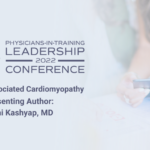Abstract | April 5, 2022
Cocaine associated Cardiomyopathy
Learning Objectives
- Cocaine-induced angina is a well-understood problem but cocaine-induced cardiomyopathy and heart failure and treatment options are poorly understood. Clinical outcomes in heart failure in patients with concurrent cocaine use were studied by Jonah et al, who reported such patients to have higher hospital readmission or death compared with HF patients without cocaine use.
- In a systematic review and meta-analysis by Daniel et al, it has been suggested that chronic cocaine use led to various anatomical changes leading to diastolic dysfunction, increased heart weight, decreased LVED, and increased ventricular thickness independent of ischemic heart disease. It was concluded beta-blocker use needs further research to avoid unnecessary delay in starting a potentially effective treatment of cocaine-associated HF.
- Decisions regarding initiation of therapy are based on the patient’s initial presentation and the clinical benefit seen during follow-up.
Introduction: Cocaine drug abuse is a growing problem throughout the United States of America. The cardiac implications of angina have been well studied but the chronic cardiomyopathic effect and heart failure need to be explored further. β-adrenergic hyperactivation has been considered the underlying pathophysiology leading to cardiotoxicity and beta-blocker therapy has been considered controversial in such patients with active cocaine use. But various trials have now suggested beta-blocker therapy might be associated with clinical improvement in patients with heart failure with active cocaine use.
Case report: A 57-year-old African American male with an extensive history of cocaine abuse with multiple previous hospital admissions was admitted with complaints of not feeling better and feeling short of breath for the past 3 to 4 days. His condition worsened over the past couple of days. His labs showed a proBNP level of 5010 pg/ml and troponin I 0.044 ng/ml. The patient had tested positive for cocaine on multiple occasions during the previous hospitalization as well. EKG showed multiple sinus rhythm with lateral T wave inversions. The patient had a 2D in 2013 which showed normal left ventricular (LV) systolic dysfunction with an estimated ejection fraction (EF) of 65% and mild left atrial enlargement. Another echo from 2021 showed mild to moderate MR and trace TR and generalized LV hypokinesis with an EF of 30%. Lexiscan showed no EKG changes and normal pharmacological stress myocardial perfusion. CTA chest with contrast showed an enlarged heart with features suggestive of right heart failure with bilateral pleural effusion and diffuse intralobular septal thickening and faint bilateral ground-glass opacities suggestive of pulmonary edema.
Management: The patient was initially being treated with amlodipine for hypertension but given his echo finding it was switched to carvedilol and spironolactone. The patient’s serial transthoracic echogram showed a declining left ventricular ejection fraction with the background of cocaine abuse. This is consistent with the development of heart failure possibly secondary to cardiomyopathy secondary to cocaine abuse.

